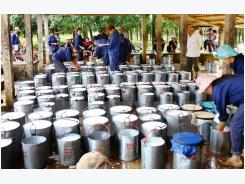Mexicos rice import plan may open door for Vietnamese grain

Farmers on a rice paddy field in Phu Tho near Hanoi. Reuters/Kham
The plan could help Vietnam's rice shipments rebound from an eight-year low in 2016.
The Mexican government has given the green light for 150,000 tons of rice to be imported at a zero percent tariff to meet domestic demand and diversify its supply sources, a move that would cut the market share currently held by the U.S. and open the door to Vietnamese rice, the Mexican government and traders said.
Imports of both paddy -- or unhusked rice -- and milled rice, can take place before the end of 2017, the Mexican government said in a statement published on its Official Gazette on March 1.
Even though Mexico's rice output grew more than 8 percent per year from 2012-2016, it could not meet domestic demand, and the country still had to import 82.6 percent of its needs from "mainly a single supply country", the statement said.
Mexico imports paddy only from the United States, and milled rice from Uruguay, with which it has signed free-trade agreements, according to Vietnam's Industry and Trade Ministry. Thailand, the world's second-biggest rice exporter after India, also sells its long grain to Mexico.
The zero-tariff import plan could help increase rice shipments from Vietnam, the world's third-largest exporter, after it lost its rank in 2015 of being Mexico's second-biggest supplier as a result of a 20 percent tariff on rice imports.
Vietnam sold 67,000 tons of milled rice to Mexico in 2014, soaring from 12,000 tons the previous year, according to the U.S. Rice Federation, which represents the voice of the U.S. rice industry.
While the Mexican government's plan may not boost Vietnamese rice exports immediately, it has made the market "nervous" as it would reduce its reliance on U.S. rice imports, which usually stand at around 800,000 tons a year, the U.S. industry body said in a February report on its website.
“For a long time, Mexico has been an almost exclusively paddy market and a lock for U.S. exporters,” Brian King, chairman of USA Rice and of USA Rice’s Western Hemisphere Promotion Subcommittee, was quoted as saying in another report published on March 2 by the federation.
"While the United States still dominates the paddy market, Uruguay has supplanted U.S. as the leading milled rice origin for what the trade reports as having better quality,” he said. Last year U.S. milled rice exports to Mexico fell to a record low of 49,000 tons.
Traders in North America said the current price spreads are not large enough to favor Asian rice over U.S. grain, and that these spreads need to be significant to offset foreign exchange risks, increased delivery times, and potential phytosanitary issues.
"However, the threat of increased Asian imports does exist, especially as the potential for price spreads widens," the federation's report said.
U.S. long grain grade 2, 4 percent broken stood at $438 a ton in 2016, or $42 a ton above Thai 5-percent broken grain, narrowing from $104 the previous year, based on data from the U.N. Food and Agriculture Organization in its March 2017 report. The gap further narrowed to $34 a ton in February this year, the report said.
Vietnamese 5-percent broken rice prices were $20-$40 a ton below Thai grain in the first two months of 2017, the FAO said.
Vietnam has seen a slow start for rice exports in 2017, with shipments falling on thin demand in key markets in Southeast Asia and Africa.
January-February's rice exports dropped 17 percent from a year ago to 799,000 tons, the agriculture ministry said. The country plans to export around 5 million tons of milled rice in 2017, slightly up from last year's 4.8 million tons, the lowest since 2008.
"Despite the small quantity, Mexico's plan is a good push for Vietnam's rice market which has been slow so far this year," a Vietnamese trader at a foreign firm in Ho Chi Minh City said.
Mexico said it would allow rice importers three shipments each with a maximum of 10,000 tons a time by December 31, 2017.
Related news
Tools

Phối trộn thức ăn chăn nuôi

Pha dung dịch thủy canh

Định mức cho tôm ăn

Phối trộn phân bón NPK

Xác định tỷ lệ tôm sống

Chuyển đổi đơn vị phân bón

Xác định công suất sục khí

Chuyển đổi đơn vị tôm

Tính diện tích nhà kính

Tính thể tích ao



 Thailand sells 1 million tonnes of rice at…
Thailand sells 1 million tonnes of rice at…  Vietnam sees full state exit from sugar mills…
Vietnam sees full state exit from sugar mills…